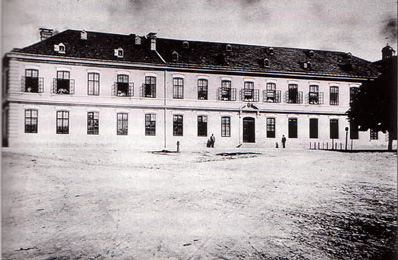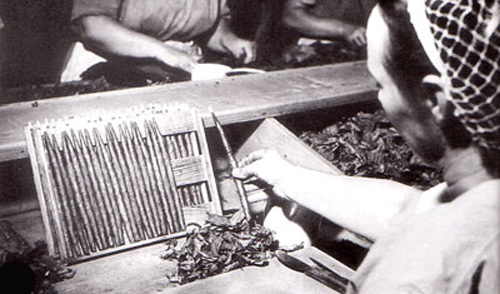As the only public university for continuing education within the German-speaking world, the University for Continuing Education Krems sets the standards for lifelong learning. In 1995, it opened its doors to students and was first created as a competence center for scientific specialization that focused on the pressing challenges at the time designing study courses accordingly. Since its foundation, the University for Continuing Education Krems (Danube University Krems), as a public university, has a deep impact on dealing with challenges society faces.
From pilot project to leading university of continuing education
In the early 1980’s, the idea was born to create a new type of university in Lower Austria. In 1987, the provincial scientific academy began developing a postgraduate program, and in 1994 the National Assembly moved to build a university center for continuing education. This laid the cornerstone for the inauguration of Danube University Krems in 1995.
Danube University Krems has its roots in the early Eighties. When the then Provincial Governor, Siegfried Ludwig, pledged his commitment to an own provincial capital, plans for a university in Lower Austria were also formed. Not as competition for the large, traditional universities in Vienna, but as an innovation. The brainstorming sessions of the workgroup “University Institutions in Lower Austria” ranged from an environmental, third world and even peace university. To focus on university-based continuing education is the decision made by the State of Lower Austria and the Federal Government and considered from different perspectives is the ultimate proof for future-oriented thinking.
In 1987, a provincial scientific academy in Krems began working on developing postgraduate programs. At the end of 1990, after a working agreement was concluded with the Federal Government, “Danube University for postgraduate and continuing education“ was projected. Then, in the spring of 1994, the National Assembly moved to build the “University Center for Further Studies, to be named Danube University Krems.” On 13 September 1995, the university finally opened its doors on the premises of the former tobacco factory Krems Stein.
Founding principles
- Danube University Krems is a postgraduate university.
- Continuing education at Danube University Krems is based on three pillars: teaching, research, and service.
- Danube University Krems is a public university guided by private sector criteria.
- Danube University Krems strategically focuses on the future whilst imparting responsible thinking and behavior.
- Danube University Krems is cosmopolitan and yet deeply rooted.
- Danube University Krems puts quality first. It is small and focuses on its customers’ needs.
- Danube University Krems is a campus university, a cultural center and meeting place.
Courses start in the winter semester 1995/96

Courses began only a few weeks after inauguration with 93 students enrolled in three majors in European Integration and Journalism. Right after starting the on-campus operation, Danube University Krems implemented further innovations in the Austrian academic landscape; i.a. in September 1997, when the university was entitled to award the then novel academic degree Master of Advanced Studies. One month later, the first Austrian master‘s degrees were awarded in the presence of the Science Minister, Caspar Einem. 1998 the graduation title Master of Business Administration (MBA) was awarded for the first time in Austria.
Despite being a publicly funded university, Danube University Krems aligned itself with modern governance and management structures. It operated like a business, hired staff in compliance with national labor regulations, implemented management by objectives and officially reported its activities in the first financial report delivered by an Austrian university. In this way Danube University Krems demonstrated its pioneering role with respect to university administration, too, and was at the forefront of the push for full legal capacity for universities, which in the meantime has been implemented. Many of the principles outlined in the “Federal Law on the University for Continuing Education Krems” have since been incorporated into the University Act 2002.
The following years laid the path to thrive in research and teaching in order to develop at a level of high quality: In 2004, the former “University Center for Further Studies” - renamed “University for Continuing Education Krems” – was deservedly awarded official status as Austria’s 22nd public university, thus obtaining the right to appoint professors and firmly establish its scientific reputation.
2014, Danube University Krems was given the right to award doctorates. Their first two PhD studies were accredited by the Agency for Quality Assurance and Accreditation Austria, AQ-Austria for short, in spring 2015. Additionally Danube University Krems’ quality management system was certified by AQ-Austria.
In 2019, it was decided to incorporate the University for Continuing Education Krems into §6 of the Universities Act 2002 (UG), in which all public Austrian universities are listed. Hereby this political resolution has sent an important signal to regard continuing education as one of the main future topics, and at the same time confirmed the development of the university. In the same year, the university was accepted as a member of the Austrian University Conference (uniko).
The amendment to the Universities Act 2002, passed in 2021, leads to a reorganization of continuing education studies in Austria. The University for Continuing Education Krems played a major role in this reform package, which sets the framework to unify continuing education studies in Austria and their integration into the Bologna structure (Bachelor - Master - PhD). Thus, in the future, there will be part-time continuing education bachelor's degree programs added to the master's degree study courses programs. Bringing academic degrees on an equivalent footing enables permeability between regular and continuation studies. The University for Continuing Education Krems plans to make use of these new opportunities in the future and is expected to implement the new continuing education studies starting in the winter semester of 2023/2024.
The most recent developments, which are milestones and set the course for the future, are designed to promote the strengthening of scientific continuing education and to make an important contribution to the Austrian knowledge and innovation system.
Lifelong learning as a trend
When, in the winter semester 1995/96, the first 93 students enrolled in Danube University Krems, a new chapter in university-based education began. The innovative university not only set standards in Austria and other German-speaking countries, it also attracted the notice of the rest of Europe. On the one hand, the pilot project that became such a success story is largely thanks to the strong commitment and forward thinking endeavors of its staff; on the other hand, it is due also to the support from regional and federal government.
Since the foundation of the University for Continuing Education Krems 25 years ago, academic continuing education has become a high priority. In particular, academic continuing education has an impact on society, especially with regard to the higher qualification of individuals to the benefit of society. As a result, competitiveness and innovative have increasingly strengthened. Continuing education in science makes an essential contribution to overcoming the major societal challenges of our time.
From a Tobacco factory to an Intellectual Thinktank
The University for Continuing Education Krems building was originally a tobacco factory, constructed at the beginning of the 20th century. The industrial building was planned by the architect Paul Hoppe, a student of Otto Wagner. Eight-hundred laborers rolled Virginier cigars here for nearly 70 years. In 1995 the tobacco factory was adapted and converted into a university for advanced education. In 2005 it was expanded into the Campus Krems and received a modern counterpart made of glass, steel and aluminium.

The cigar factory was established in Stein, in the district of Krems, because of its favorable traffic situation on the banks of the Danube and because of its proximity to Vienna. The old tobacco factory building which is separated from the "new" building by the Stein prison, houses the Kunst.Halle.Krems (Art Hall of Krems) today. This house was originally a restaurant, purchased by the Ministry of Finance in 1850 by official order. The production of cigars was started here just three months later. In 1865 about 600 laborers were producing more than 41 million cigars. The Virginia, a 20-centimeter-long, thin, slightly curved cigar made from strong Virginia and Kentucky tobacco, with a straw in its core, became a speciality of the Tobacco Monopoly’s range of products and one of the most popular cigars among the population of Vienna. Therefore, despite numerous financial difficulties the authorities decided to build a new Virginier factory in 1918.
Annual production of more than 75 million cigars

The three-storied ferroconcrete skeleton structure in the form of a "third baroque" building which houses the University for Continuing Education Krems today was constructed between 1919 and 1922. The new factory was inaugurated on 16 June 1922 by Dr. Karl Dorrek, who was the Executive Director of the Tobacco Factories at the time. The street adjoining the building was named after him later on. The Austria Tabakwerke (Austrian Tobacco Factories), previously known as the Austrian Tobacco Monopoly was a "social model" among Austria’s industrial institutions. It created a large number of charitable facilities like invalid and health insurances, treatment rooms for the company doctor, a company canteen and a public bath for laborers, children’s homes and – by the standards of those times – large apartments for laborers.

For a few decades, about 800 laborers produced Virginier cigars manually in the new factory. In 1931 the factory achieved its highest production standard – it was producing 75 million cigars. On account of the drop in the consumption of cigars, the production had to be reduced from the 1980’s. In 1991 it was fully stopped. Thus, the Virginier factory in Stein – along with a shoe factory in the Krems valley – was the largest and most important employer for the female population of Stein and its environs for a period of more than 100 years.
Sensitively re-designed according to Manfred Wehdorn’s plan
This building – after being transformed from a tobacco factory to a university for advanced education – is again playing an important role in this region today. It is the work-place of about 700 individuals, a pulse generator in terms of science, and a cultural meeting point. In 1987, when it was decided to establish the Academy of Science in the Province of Lower Austria, the architect Manfred Wehdorn was asked to re-design the historical building in the tradition of the "hometown style". The reconstruction was planned with due regard to preserving and protecting the historical building, and also in accordance with economical criteria. The historical height of the rooms was not altered so that the charm of the industrial building could be retained. In 1995 Danube University Krems moved into the newly adapted rooms. The middle tract of the building was renovated and extended from 2002 to 2003.
In 2003, the construction of the new Campus Krems started simultaneously and officially opened on 7 October 2005. The modern building, a design of steel, glass and aluminium located on the opposite side of the existing building, embeds harmoniously into the historical landscape and offers space to parts of the IMC University for Applied Sciences alongside those of Danube University Krems. In the new building's process of construction, a modern biotech laboratory center was built for Danube University. In 2016 and 2018, the Light Laboratory and the Core Facility for Research, both of which Danube University Krems shares with the other on-campus universities, complete the research infrastructure.
In 2019, the Federal Government and the State of Lower Austria signed the agreement according to paragraph 15a B-VG on rising financial and infrastructural resources to lay the basis for 10,000 m2 of additional space, which the State of Lower Austria made available.


